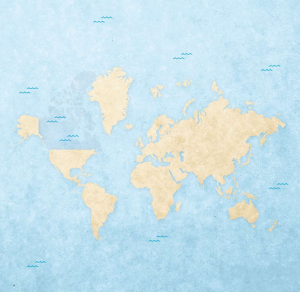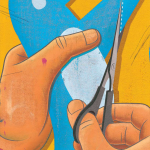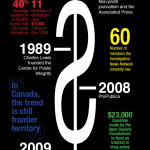Too Scared to Try
Around the world, newspapers are boldly experimenting with online infographics—and they're making money. So, what's your problem, Canada?
 Hundreds of rings cover a satellite image of Japan’s eastern coast on The New York Times website. The largest ring, which looms over the curve in the land near the city of Fukushima, shows a 9.0 magnitude on the Richter scale; it represents the earthquake that shook the country and caused the devastating tsunami that flooded coastal cities and towns and set off a national nuclear crisis. Since March 11, Japan has been rattled by hundreds of aftershocks and has had to issue more tsunami warnings to coastal regions, months after the fact. One aftershock, at a magnitude of 7.1, hit on April 7, nearly a month after the initial quake. Mousing over the rings on the map highlights each quake, displaying its date and magnitude.
Hundreds of rings cover a satellite image of Japan’s eastern coast on The New York Times website. The largest ring, which looms over the curve in the land near the city of Fukushima, shows a 9.0 magnitude on the Richter scale; it represents the earthquake that shook the country and caused the devastating tsunami that flooded coastal cities and towns and set off a national nuclear crisis. Since March 11, Japan has been rattled by hundreds of aftershocks and has had to issue more tsunami warnings to coastal regions, months after the fact. One aftershock, at a magnitude of 7.1, hit on April 7, nearly a month after the initial quake. Mousing over the rings on the map highlights each quake, displaying its date and magnitude.
This interactive graphic was part of a multi-layered online feature created by the Times that included animated diagrams, heat maps, interactive before and after images, videos and slideshows. The coverage captured the devastation of the disaster in a way that text could not.
Meanwhile, The Globe and Mail and the National Post created colourful but flat graphics—maps with the locations of the Fukushima power plant and the fault line (where the tectonic plates shift), for example. The Toronto Star created a timeline and used a Google map to track the location of stories from the quake’s aftermath. In comparison to what the Times offered on its website, where users could interact with and explore the information, the graphics at some of Canada’s largest papers functioned essentially as diagrams—the same role they’ve been playing for decades and in the same two-dimensional form.
Major news organizations in the United States and overseas are using online infographics to bring in huge traffic and advertising dollars. But Canadian papers have not caught on to the trend, and they’re foregoing readers—why go to a website with dull graphs and timelines when the same information is available in a more engaging and dynamic form elsewhere? Our newspapers are dying and we’re still not taking full advantage of the possibilities graphics offer. Meanwhile, publications across the border are reinventing the news online, driving traffic and making money—and it’s helping them survive.
Infographics include maps, charts and graphs, which means they’ve been around since long before Gutenberg’s printing press. In 1702, Britain’s Daily Courant published what is believed to be the first infographic in a daily newspaper: a diagram of Britain’s attempted occupation of the Bay of Cádiz in Spain.
In the past, infographics tended to work as a complement to text, but today, with advances in software and with their growing popularity, they frequently stand alone. The Globe and Postsometimes publish full pages, or even double-page spreads, of graphics, without a supporting article. One of the maps of the disaster in Japan published by the Post took up a full page of the paper’s front section and was accompanied by eight photos of the devastation along with the latest statistics on the missing and dead.
Infographics also grew alongside data journalism: reporting based in numbers, statistics, information gathered via freedom-of-information requests or data pulled from websites or documents. Here, graphics are a way to make sense of information, especially numbers, more than a way to further storytelling.
Some print journalists fear that the success of infographics is a symptom of waning attention spans, rather than true innovation in the practice. But David Pratt, a designer at the Globe, says graphics cater to the way people naturally consume information. Citing an eye-tracking study done by the Poynter Institute, he says that people don’t actually read print articles from beginning to end; our eyes skip and jump, and we tend to see pictures before text.
Online graphics help promote interest in stories, but their popularity can sometimes mean compromising journalistic standards. After Osama bin Laden was killed on May 1, newspapers around the world tried to depict the U.S. mission using images. Visualjournalism.com published a critique of some of these graphics, including an eight-picture slideshow of drawings made by UOL, an online news site in Brazil, which portrayed chaotic scenes of armed men shooting in all directions. Visualjournalism called the drawings “pure crap…which doesn’t even make an attempt to get the facts right.” Infographics from other news organizations added details and decorations to their images, including hills and explosions, before that information even came out.
That news sites are willing to publish inaccurate infographics for the sake of driving hits speaks to infographics’ ability to draw readers in, regardless of their quality. Craig Silverman, editorial director at OpenFile, says even advertisers are catching on to the potential of online graphics, and the fact is that users spend more time with an ad that is animated or interactive.
The same applies for news graphics. The real advantage of infographics is they encourage readers to stick around long enough to absorb the message and explore the rest of the website. Graphics don’t have to be a huge investment: OpenFile’s Ottawa editor, Nick Taylor-Vaisey, says his reporters use simple and mostly free online tools to create them.
The danger is that they’ll become a quick fix in the online world. “I’m almost wary of running a ton of them on OpenFile because it seems like a cheap way to get hits,” he says. “It’s kind of baffling that not everyone is doing it.”
While some online sites such as OpenFile are enthusiastic about including infographics on their websites, most Canadian newspapers have little faith in graphic art. Few invest in their own artists and, when they do, they rarely post unique content online. The Star, which had a large graphics team and published Patrick Cain’s “Map of the Week” for two years on its website, recently laid off four of its artists and now contracts out online maps.
Miguel Vadillo, the senior designer at the paper, says the depleted department is left to make “stupid little maps and stupid little graphics.” He says the newspaper doesn’t take infographics seriously or recognize their potential to increase the overall quality of the paper and bring in more revenue. He thinks good design and engaging graphics have the potential to keep dying print publications alive, if only news organizations would invest in them.
Murdoch Davis, executive editor at the Star, counters that his paper does understand the importance of infographics. “The consensus is that print will slowly decline and digital will continue to explode. It follows naturally that interactive and online graphics will be part of that,” he says, adding that the Star’s layoffs were not limited to the graphics department and that many of the paper’s other journalistsalso have graphic design skills.
Nevertheless, Davis admits the paper probably publishes fewer infographics now than it did before the layoffs. He intends to hire people who can create more complex online content, though graphic design may not be their only, or primary, skill. He says that major newspapers in this country may look more like their American counterparts in the future, but they need to deal with their own obstacles, such as union negotiations.
Don Wittekind, who was a professor of visual communications in the journalism program at the University of North Carolina at Chapel Hill and now runs his own interactive and animated graphic design business, says infographics drive traffic to websites long after they first appear. He believes some newspapers are losing sight of long-term goals in favour of short-term benefits; they think they’re saving money when they make cuts to the graphics department. And even when smaller papers see large publications such as the Times make good on their investment in infographics, they are too frightened by the potential cost to follow suit.
Meanwhile, many Canadian newspapers don’t seem to have a strong sense of how to make graphics work for them and are not able, or willing, to take advantage of the tools available online. Graham Huber, a professor of design at Toronto’s York University who has lectured on the use of graphics as a communication tool in media and academia, says news organizations are stuck making websites that look just like the paper. “There’s this really awkward puberty that journalism is going through right now,” he says. “It doesn’t know what it is—newspapers are trying to be websites and websites are trying to be magazines.”
That leaves this country far behind the rest of the world, according to Lucie Lacava, a Montreal-based design consultant who has helped redesign newspapers in eight countries. “In Canada, the graphics I’ve seen from judging in competitions, they’re more like what you’d find in an encyclopedia,” she says. “There isn’t much of a budget or effort put into graphics in Canada.” Part of the problem is that most newsrooms don’t ask their graphic artists to be journalists and the artists don’t have a chance to see first-hand what they’re trying to portray visually. Before the internet became the first point of reference, graphic artists used to call sources and would visit the scenes they were depicting.
But the Post still encourages its artists to do their own investigating. This past summer, graphics editor Richard Johnson went to Kandahar to illustrate the lives of Canadian soldiers and civilians. He sees this as proof that the Post takes art seriously. Since he began working there in the late 1990s, he’s even managed to hire a few new graphic artists.
Though Johnson admits the paper doesn’t have much unique content online, the graphics that it does feature bring in traffic because they are clever and well made. The Post has consistently won awards at the Society for News Design’s “Best of News Design” annual competition; in 2011, Johnson earned a National Newspaper Award nomination for an infographic that transcended the genre’s cutesy reputation by tackling a grim topic head-on. It depicted the stoning of a woman meant to illustrate the prospective fate of Sakineh Mohammadi Ashtiani, an Iranian woman accused of adultery. The graphic shows how the woman would be tied and wrapped in cloth and the suggested rock sizes, as written in the Islamic Penal Code.
Still, though there is plenty of talent in Toronto newsrooms, the Post and the Globe are barely ahead of the rest of Canada when it comes to online content. Postmedia, like most other media chains in Canada, has been struggling with how to move forward without Flash since the boom in iPhones and iPads, neither of which support the program. The company is not offering specific training on alternative programming languages and, according to Johnson, is not hiring those with the skills to work around the problem.
Forward-thinking Canadian journalists are making an effort to learn how to create online infographics, most without the support of their employers. Hacks/Hackers, a group that brings journalists and computer geeks together to discuss the future of news online, has developed a strong following. It began in the United States, but now has branches in Toronto, Vancouver, Ottawa and Montreal.
Many journalists are using the group to make connections and learn how to access, filter, manipulate and present data online—anything from “scraping” (extracting data from) websites to programming and designing interactive infographics. “You kind of have to do this if you want to be on the edge, because readers demand it,” says Taylor-Vaisey. “It’s exciting because not everyone is doing it. You kind of feel like you’re leading the way.”
Recently, Lucas Timmons and Ryan Jackson of the Edmonton Journal worked on a guided, interactive, 360-degree tour of Slave Lake after the wildfire this past May. Producing it involved stitching together four videos and customizing a player to show the tour on the website. They completed the project before most of the residents of Slave Lake returned to the town—they were able to see if their homes were still standing before they were even allowed to go back to them. Timmons says the Journal has always been supportive of new online projects and it has given him free rein to use his programming and design skills to improve the website.
Newspapers can get so caught up trying to “feed the beast”—the pages, the website—that they stop thinking about the bigger picture. They complain all the time about declining reader numbers, but if they want to retain old readers and find new ones, maybe it’s time to start telling new stories in different ways.
by Claire Prime
Claire Prime was the Production Editor for the Winter 2012 issue of the Ryerson Review of Journalism.












































